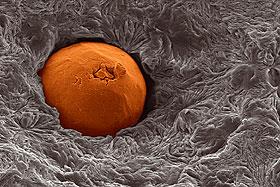Thermally Conductive Polymers

| Copperball in Polymer Matrix |
The sector of mechatronics engineering is characterized by the tendency towards miniaturization and the integration of components, which certainly increases technological demands. Therefore, new approaches are constantly becoming more and more necessary. An approach to find a solution for these tasks is represented by employing functional plastics with defined thermal and electrical properties. This is a promising option to integrate additional functions into complex components. Plastics are given their electrical and/or thermal functions by metal particles or fillers on a carbon or graphite basis added. Additionally, in some cases ceramic fillers are added as an alternative to increase thermal conductivity. Ceramic fillers such as AlN, Al2O3 or BN are able to achieve heat conductivities of up to 10 W/mK. Due to their electrical insulation capacities, these materials are suitable for casings in electronic components to dissipate heat.
Fillers with good thermal and electrical conductivity properties, e.g. copper, can lead to values of heat conductivity up to 20 W/mK – yet, this implies a loss of electrical insulation. With heat conduction values up to 104 S/cm, such plastics are well-suited as a built-in anti-electrostatic feature or for electromagnetic screen attenuation. Moreover, highly conductive compounds can also be used to conduct electricity in e.g. heating elements.
When it comes to manufacturing complex components with thermal and electrical functions via techniques such as injection molding or extrusion, processing conditions vary and the engineer has such factors into account, as well as optimization possibilities and processes alignment. In addition, the final component’s properties are affected by both material properties as well as processing. Anisotropic fillers and process-related filler orientations result in local and overall anisotropic properties. This fact is essential when components are designed to meet the demands of application and function. To reach this target, a vast range of instruments is at hand for a simulative lay-out of processes and components.
Dr.-Ing. Uta Rösel
Institute of Polymer Technology
Processing (Head of Department)
- Phone number: +49913185-71002
- Email: uta.ur.roesel@fau.de
